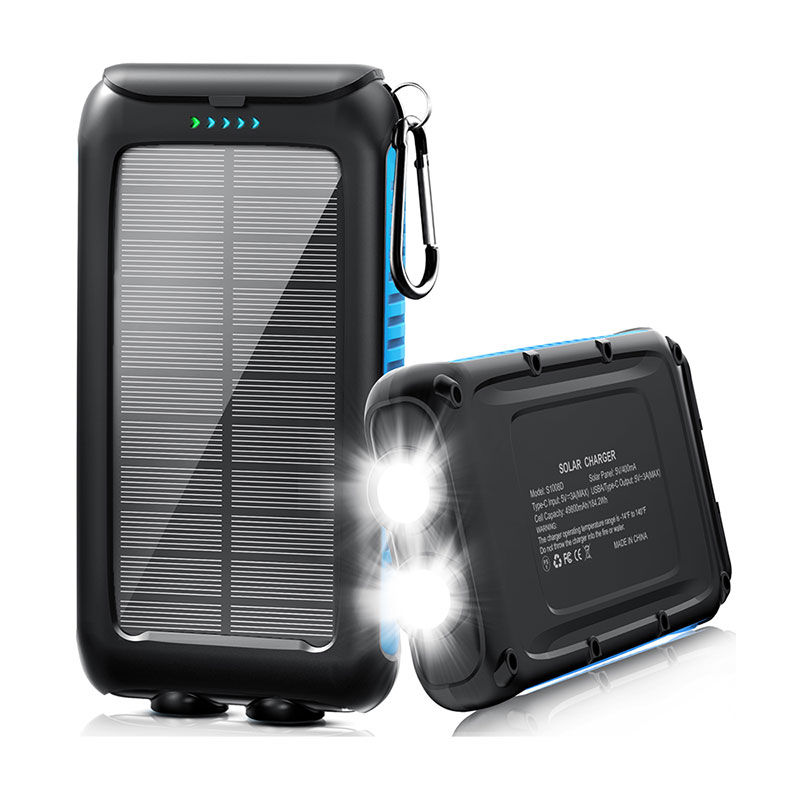
- English
- Español
- Português
- русский
- Français
- 日本語
- Deutsch
- tiếng Việt
- Italiano
- Nederlands
- ภาษาไทย
- Polski
- 한국어
- Svenska
- magyar
- Malay
- বাংলা ভাষার
- Dansk
- Suomi
- हिन्दी
- Pilipino
- Türkçe
- Gaeilge
- العربية
- Indonesia
- Norsk
- تمل
- český
- ελληνικά
- український
- Javanese
- فارسی
- தமிழ்
- తెలుగు
- नेपाली
- Burmese
- български
- ລາວ
- Latine
- Қазақша
- Euskal
- Azərbaycan
- Slovenský jazyk
- Македонски
- Lietuvos
- Eesti Keel
- Română
- Slovenski
Why Are Solar Power Banks Becoming the Smart Power Choice Today?
2025-11-14
A solar power bank is a portable charging device that stores electrical energy converted from sunlight through integrated solar panels or high-efficiency photovoltaic cells. As outdoor mobility increases and consumers demand reliable off-grid charging, solar power banks are emerging as a practical, eco-friendly solution.
A solar power bank works by absorbing sunlight through solar cells, converting this energy into electrical power, and storing it inside a built-in lithium battery pack. The stored energy can later charge mobile phones, tablets, wireless earbuds, cameras, and other devices. The increasing shift toward energy independence and sustainable outdoor lifestyles has boosted its popularity across hiking, travel, emergency preparedness, and daily charging scenarios.
Product Parameters Overview (List Format for Professional Clarity)
-
Solar Panel Type: High-efficiency monocrystalline photovoltaic panel
-
Battery Capacity: 10,000mAh / 20,000mAh / 30,000mAh options
-
Battery Cell Type: Lithium-polymer
-
Charging Methods: Solar charging + Type-C input + USB input
-
Output Ports: Dual USB-A output + Fast-charge Type-C output
-
Waterproof Rating: IP65 or above
-
Protection System: Over-voltage, over-current, over-heat, short-circuit protection
-
Additional Features: LED flashlight, emergency SOS mode, foldable solar panels (optional)
-
Shell Material: ABS + PC fire-resistant casing
-
Weight Range: 250g–600g depending on capacity
-
Working Temperature: –10°C to 45°C
-
Application Scenarios: Outdoor travel, emergencies, camping, blackout situations, off-grid environments
This parameter list allows consumers to quickly identify the technical strengths and performance characteristics of a modern solar power bank, ensuring they understand capacity, safety, durability, and versatility before making a purchase.
Why Does a Solar Power Bank Matter for Everyday and Outdoor Use?
Solar power banks are no longer niche products; they have become mainstream tools of convenience and reliability. The shift toward outdoor recreation, remote work, and sustainable lifestyles has driven this product category into higher demand.
Why Solar Charging Offers Practical Value
Solar power banks offer energy independence in situations where traditional power outlets are not accessible. Sunlight becomes a renewable power source available almost anywhere, solving the problem of low battery anxiety during long outdoor trips or blackout emergencies.
Why Battery Capacity and Output Speed Matter
Large capacities—20,000mAh or above—allow multiple full charges for smartphones. Fast-charge technology ensures that power delivery meets the demands of modern devices without unnecessary waiting time. Dual-port or triple-port output ensures simultaneous charging, making it ideal for group activities or families.
Why Durability Enhances Reliability
Waterproof ratings such as IP65 ensure functionality in rain, dust, or wind. This durability makes the product suitable for rugged outdoor use, a key reason why hikers and travelers prefer solar power banks over ordinary power banks.
Why Safety Protection Is Crucial
The presence of a multi-layer protection system ensures that the device operates safely across different environments. Over-voltage and over-current protection prevent battery damage. Short-circuit protection protects user safety during intense outdoor activities.
Why Added Features Create Real-World Benefits
Emergency LED flashlights, SOS modes, and multiple solar panels provide added value. These features transform the power bank from a simple charging device into an emergency survival tool. The multifunctional nature increases user confidence and product reliability.
How Does a Solar Power Bank Work and How Can It Be Used Efficiently?
Understanding how a solar power bank works helps users maximize its performance and extend its lifespan.
How Solar Charging Works
Solar photovoltaic panels collect sunlight, converting it into direct current. The built-in solar controller regulates this power before storing it in the lithium battery. When devices need charging, the stored energy is output through USB or Type-C ports.
How to Achieve Efficient Charging
Efficient solar charging depends on several factors, including sunlight intensity, placement angle, temperature, and the type of solar cells used.
-
Optimal Sunlight: Direct sunlight is required to maximize conversion efficiency.
-
Best Placement Angle: A 30°–45° angle increases exposure and absorption.
-
Temperature Consideration: Moderate temperatures improve charging stability.
-
Pre-Charging: Using Type-C input to fully charge the battery before travel improves usability.
Using these principles ensures that users always maintain adequate power levels, especially during long outdoor trips.
How Port and Capacity Planning Improves Usage
Choosing the right capacity helps users avoid insufficient charging during multi-device use. For example:
-
10,000mAh suits short trips.
-
20,000mAh suits daily use and two-day outdoor travel.
-
30,000mAh suits multi-device or long-distance adventures.
Planning capacity according to actual needs increases efficiency and avoids unnecessary weight.
How Design and Build Affect Long-Term Performance
-
Shock-resistant casing protects internal components.
-
Waterproof construction maintains stability in unpredictable outdoor conditions.
-
Quality battery cells extend the lifespan and reduce energy loss.
Users relying on solar power need products with consistent performance, and structural design plays a crucial role.
What Future Trends Will Shape the Next Generation of Solar Power Banks?
The solar power bank industry is transitioning from basic charging capabilities to smart energy-management systems. Several emerging trends are worth noting.
Trend 1: Higher-Efficiency Solar Panels
Future products will use upgraded monocrystalline cells, increasing conversion efficiency. This trend allows faster charging even under limited sunlight.
Trend 2: Smart Energy-Management Chips
Advanced control systems will regulate input/output with greater precision. These chips optimize battery health, charge speed, and adaptive power delivery.
Trend 3: Lightweight and Compact Designs
Manufacturers are working toward reducing weight while increasing battery density. This shift results in easier portability without sacrificing capacity.
Trend 4: Integration with Outdoor Gear
Solar power banks will increasingly integrate with backpacks, tents, and outdoor accessories. This hybrid approach transforms them into built-in charging ecosystems.
Trend 5: Green Energy Expansion
As consumers embrace sustainable energy, solar power banks will become part of a larger clean-energy network. They will connect with solar home systems, camping generators, and portable panels for broader energy independence.
Frequently Asked Questions (Q&A Format)
Q1: How long does a solar power bank take to fully charge under sunlight?
A solar power bank typically requires 25–50 hours of direct sunlight for a complete solar charge, depending on its battery capacity and the efficiency of the solar panels. Solar charging should be considered a supplementary power source, while USB charging is used to achieve full capacity before outdoor use. Weather, sunlight intensity, and panel size all influence charging speed, so users should aim to charge the device under strong midday sunlight for the best results.
Q2: Can a solar power bank charge multiple devices at once without reducing performance?
Yes, dual or triple output ports allow simultaneous charging of multiple devices. However, total output power is divided among the connected devices. Fast-charge compatibility ensures that each device receives efficient, stable power delivery. For heavier loads like tablets or cameras, it is recommended to use the fast-charge Type-C port to maintain optimal performance, ensuring quick and safe charging without overheating.
Conclusion: How Solar Power Banks Support Modern Energy Needs
Solar power banks provide sustainable energy solutions for users who require stable, mobile, and eco-friendly charging options. With advancements in battery technology, solar efficiency, safety systems, and outdoor durability, they have become essential in both everyday life and wilderness environments. As future trends continue to improve performance, efficiency, and smart functionality, the solar power bank will remain a valuable tool for modern consumers seeking dependable portable energy solutions. The brand Quacoa continues to develop high-quality solar power bank products designed to meet global market standards and long-term consumer needs. For more details or customized inquiries, contact us.




